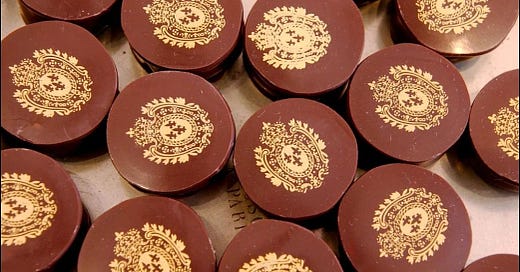Ever wondered why some hotels put a mint on the pillow when they turn down the bed?
It goes back to the time when chocolate, then solely a beverage and tonic, was drunk in bed each morning for the energy to face the day and at night to soothe one’s frazzled nerves. Long before Prozac, it was Mother’s Little Helper. (A courtier at the Versailles of Louis XIV warned her daughter not to over-indulge while pregnant, however, lest she suffer the fate of another court lady and give birth to a black baby.)
We owe the chocolate bar to Louis XVI. His queen, Marie Antoinette, needing to take a disagreeable medicine each morning, asked court pharmacist Sulpice Debauve to make it more palatable. He mixed the drug with cocoa powder, almond milk and sugar, moulding it into discs called pistoles, after the Spanish coin they resembled. They’re still sold in the Debauve et Gallais, the elegant shop he set up with his nephew on rue de Saints-Péres – first in the avalanche of bonbons that inundate us still.
The royal connection explains why chocolates, along with a bouquet of flowers, are the only suitable gift to take when visiting friends. The kind of chocolate matters, of course. A box of 24 Pistoles will set you back 38 Euros but Parisians gladly pay. Cash and chocs just go together; think of Willy Wonka and his gold tickets. In North by Northwest, Cary Grant tells his secretary to send his ex-wife “a box of candy from Blum’s. Each piece wrapped in gold paper. She’ll like that. She’ll think she’s eating money.”
Now chocolate and royalty have collided again over a humble biscuit once a staple of French supermarket shelves but now mysteriously absent. In October, the left-wing newspaper Libération revealed, with a certain glee, that Cadbury Fingers hadn’t been on sale since the spring. Nor was there any likelihood of them returning.
Among the many fans of Cadbury products was Queen Victoria, who in 1854 granted the company a royal warrant to supply chocolates to her various palaces. Subsequent rulers maintained the relationship, as, in the normal course of events, would Charles III - until the Ukraine complained that Cadbury’s current owners, Mondelez International, did business with Russia. Nothing was said publicly, but the precious warrant has not been renewed and Cadbury’s Fingers no longer appear on French shelves.
Many in this ostensibly anti-royalist nation are baffled by the politics behind the disappearance. Since when did French hypermarchés march to the beat of Buckingham Palace? However the loss of Cadbury products may just be collateral damage. Of more significance is the fact that Mondelez also manufacture numerous other chocolate products, including Toblerone, Twix and the popular Lu biscuit line. Their disappearance would leave significant gaps on the shelves.
Repercussions from the Cadbury ban can’t be long coming.According to Sophie Thiron, a doctor in the sociology of the relationships between food and emotions, “we trust industrial brands to return to a precise taste standard with each consumption experience, a standard to which attachment has been built up over the course of pleasurable experiences. When Cadbury withdraws its Fingers without warning, the trust established with the brand is shattered.” Not since the post-Brexit closure of France’s Marks and Spencer branches and their subsequent deprivation of pork pies, baked beans and crumpets has there been such disquiet in the Anglophone gourmet community. The medical community is bracing for a rise in calls for counseling and a rush for prescriptions to replace the vanished treats. Do you hear the people sing? It’s the sound of hungry men.





